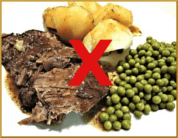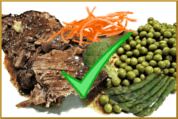food compatibility:
“Food and drink are relied upon to nurture life. But if one does not know that the nature of substances may be opposed to each other, and one consumes them altogether indiscriminately, the vital organs will be thrown out of harmony and disastrous consequences will soon arise. Therefore, those who wish to nurture their lives must carefully avoid doing such damage to them.”
– CHIA MING, Essential Knowledge for Eating and Drinking, 1368 AD.
Food Compatibility and weight loss
As you can see from the quotation above, food compatibility is not a new idea or fad diet, it’s been around for a long time but probably understood only by the educated few who could read and write during medieval times, and is the science of combining food into categories that are compatible with one another.
new idea or fad diet, it’s been around for a long time but probably understood only by the educated few who could read and write during medieval times, and is the science of combining food into categories that are compatible with one another.
The illustrations opposite will give you an idea of how some foods are incompatible with others. For example, that starchy foods, like potatoes, are incompatible with protein foods such as meat, while vegetables are compatible with most foods apart from sweet, sub-acid and acid fruits. More about this later.
of how some foods are incompatible with others. For example, that starchy foods, like potatoes, are incompatible with protein foods such as meat, while vegetables are compatible with most foods apart from sweet, sub-acid and acid fruits. More about this later.
diet – food compatibility: an aid to weight loss
Although originally created to improve problems with digestion and health, diet – food compatibility is now recognized as an aid to weight loss as there are many people who, while practicing the diet for mainly health reasons, also found they were losing weight naturally.
Dr William Howard Hay, an American physician was suffering from Bright’s Disease (Nephritis, a kidney problem), and serious heart problems. With conventional medicine unable to cure him, based on pH (potential of hydrogen), see posts pH (potential of Hydrogen) – Part 1 and pH (potential of Hydrogen) – Part 2, he came up with the concept of food combining (later to become known as the Hay diet). This embraced the idea that certain foods require an acid pH environment in digestion, and other foods require an alkaline pH environment, and that both cannot take place at the same time, in the same environment.
Realizing that different foods have different digestion times, and incompatible foods can affect good digestion, he started practicing food combining and found that gradually, due to practicing food compatibility, his health and fitness improved and claimed that it cured his Bright’s Disease.
With regards to food compatibility, the following will give you the digestion times of some principal food and drink.
Table I
| Water When Stomach is Empty, leaves immediately and goes into Intestines. Juice Fruit, vegetables, vegetable broth: 15 to 20 minutes. Semi-Liquid blended salad, vegetables or fruits 20 to 30 min. Fruit Watermelon: 20 minutes. Other melons: Cantaloupes, Cranshaw, Honeydew etc: 30 minutes. Oranges, grapefruit, grapes: 30 minutes. Apples, pears, peaches, cherries etc: 40 minutes. Vegetables Raw tossed salad vegetables: tomato, lettuces, cucumber, celery, red or green pepper, and other succulent vegetables: 30 to 40 minutes. Steamed or Cooked Vegetables Leafy vegetables: escarole, spinach, kale, collards etc: 40 minutes. Zucchini, broccoli, cauliflower, string beans, yellow squash, corn on cob: 45 minutes. Root vegetables: carrots, beets, parsnips, and turnips etc: 50 minutes. Semi-Concentrated Carbohydrates (Starches) Jerusalem artichokes, acorn and butternut squashes, corn, potatoes, sweet potatoes, yam, chestnuts: 60 minutes. Concentrated Carbohydrates (Grains) Brown rice, millet, buckwheat, cornmeal, oats: 90 minutes. Legumes and Beans (Concentrated Carbohydrate and Protein) Lentils, limas, chick peas, peas, pigeon peas, kidney beans, soy beans, etc:: 90 to 120 minutes. Seeds and Nuts Seeds: Sunflower, pumpkin, pepita, sesame: 2 hours. Nuts: Almonds, filberts, peanuts (raw), cashews, brazil, walnuts, pecans, etc: 2½ to 3 hours. Dairy Skim milk, cottage or low fat pot cheese or ricotta: approx. 90 minutes. whole milk cottage cheese: 120 minutes. whole milk hard cheese: 4 to 5 hours. Animal Proteins Egg yolk: 30 minutes. Whole egg: 45 minutes. Fish: cod, scrod, flounder, sole, seafood: 30 minutes. Fish: salmon, trout, herring, (more fatty fish): 45 to 60 minutes. Chicken (Without Skin) 1½ to 2 hours. Turkey: (Without Skin) 2 to 2¼ hours. Beef, lamb: 3 to 4 hours. Pork: 4½ to 5 hours. |
Basically food combining consists of three categories: Protein, Vegetables (Neutral), and Carbohydrates. Protein and carbohydrates should never be eaten together but the neutral foods can be eaten with either protein or carbohydrates.
As an example, meat should not be eaten with potatoes (so much for the Sunday roast!). Fruit should be eaten before, not after or during a meal, as they contain simple sugars that are quickly digested but if eaten with most other foods that require longer digestion times they can lie in the stomach and ferment causing indigestion.
Remember, fruits maybe nourishing and jam-packed with the vital vitamins and minerals but it is digested so quickly that it doesn’t mix well with starches and proteins. Yogurt and all kinds of fruit go well together.
Acidic fruits such as apples and oranges can be a particular problem if they are eaten too close to a starchy meal.
Banana is the only really flexible fruit. It’s quite starchy so banana is good with porridge and cereals but it is also easy to digest, so goes well with yogurt.
In practice, eating three meals a day, with around four hours between each meal is advisable; meal one should consist of alkaline foods only, meal two of protein foods with salads and vegetables, meal three of starchy foods with salads and vegetables. Also two high protein foods should not be eaten at the same meal.
In the table below foods in red (Proteins and Cabohydrates) should never be eaten together but foods in green can be eaten with either.
Table II
| Protein Meat lean beef, veal, lamb, mutton, lean pork, venison, chicken, turkey, duck, goose, game (of all kinds) Fish (including shellfish) cod, halibut, herring, mackerel, pickerel, pike, salmon, shad, sturgeon, trout, clams, crabs, lobsters, oysters. Legumes (Recommended for Vegetarians but not generally, as Legumes contain varying amounts of Starch) dried beans (of all kinds), dried peas, lentils, peanuts, green peas, both green and dried lima beans Dairy Products *(bar cream and butter) milk, buttermilk, cheese(of all kinds), eggs, yogurt. *(Cream and Butters contain little or no Protein). Fruit Apples, Apricots (fresh or dried), Blackberries, Blueberries, Cherries, ripe black, red or white Currants, Gooseberries (*Best eaten on its own as a Snack or as a Fruit Meal). |
| Neutral Succulent Vegetables All Green and Root Vegetables except Potatoes (including Sweet Potatoes) and Jerusalem Artichokes. Pumpkin. (Although there are many Succulent and Salad Vegetables, the following are some of the Principal Ones. Asparagus, artichoke, aubergines, beets, broccoli, Brussels sprouts, cabbage, carrots, cauliflower, celery, chard, cone, *corn, courgettes, cucumber, dandelion, egg plant, endive, garlic, green peas kale, Kohlrabi, marrow, mushrooms, lettuce, lotus, okra (gumbo), onions, oyster plant, parsnips, radish, rutabaga (swede), spinach, string beans, summer squash, tomatoes, turnips, turnip tops. Salad Vegetables avocados, celery, chicory, cress cucumber, endive, fennel, garlic, Lettuce, peppers (red green), parsley, radishes, rocket, romaine, spring onions, tomatoes, watercress. (*Although a Cereal, Corn (whether on the Cob or Canned), can also be classed as a Succulent Vegetable if used in Milk) *Nuts Almonds, Brazil nuts, filberts, hickory nuts, pecans, English walnuts, butternuts, coconuts, pistachios, acorns. (*Nuts are rich in oil and can be included in oils and fats). Fats Cream, Butter and some Rich Cheeses. Pork, Mutton and Beef, which have been Fattened. herring, mackerel, shad, salmon, trout. Oils Peanuts and Soy Beans are very Oily. Also Rich in Oil are Almonds, Brazil Nuts, Filberts, Hickory Nuts, Pecans, English Walnuts, Butternuts, Cocoa Nuts, Pistachios and Acorns. corn oil, Cotton seed oil, Safflower Oil, Sesame seed oil, sunflower seed oil, and virgin olive oil are all good sources of oil. |
|
Carbohydrate Vegetables potatoes, carrots, parsnips, corn, winter squash, Jerusalem artichokes, Pumpkin, Sweet Potatoes. Grains barley, buckwheat, dried corn, maize, millet, oats, rice, wheat, rye, brown rice, wild rice, 100% wholewheat pasta and bread. Legumes beans, peas, tofu, peanuts. |
The table below will give you an easy comparison of compatible foods.
Table III
| Food Groups |
Protein | Fats | Starches | Vegetables | Sweet Fruits |
Sub-Acid Fruits |
Acid Fruits |
| Proteins | Good | Poor | Poor | Good | Poor | Fair | Good |
| Fats | Poor | Good | Fair | Good | Fair | Fair | Fair |
| Starches | Poor | X | Good | Good | Fair | Fair | Poor |
| Vegetables | Good | Good | Good | Good | Poor | Poor | Poor |
| Sweet Fruits | Poor | X | Fair | Poor | Good | Good | Poor |
| Sub-Acid Fruits |
Fair | X | Fair | Poor | Good | Good | Good |
| Acid Fruits | Good | X | Poor | Poor | Poor | Good | Good |
*For a list of Protein, Vegetable and Carbohydrate foods please refer to Table II.
I hope that this article, Diet – Food Compatibility, has helped you better understand how food compatibility works, particularly if considering introducing it into your weight loss or normal diet.
The content on this page is only a guide to Diet – Food Compatibility and for information only. If you feel you have digestion or health problems which may relate to food incompatibility, or considering using it as part of any weight loss program, please seek the appropriate professional advice before starting on any diet or fitness programs, as what may suit one individual may not suit another.
